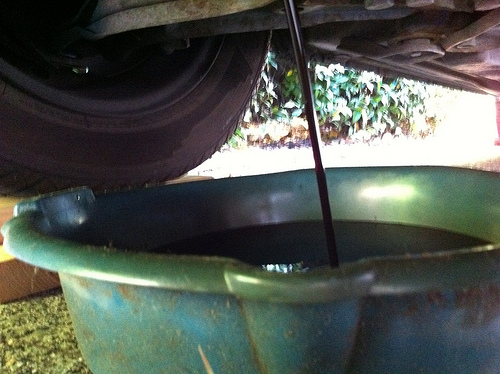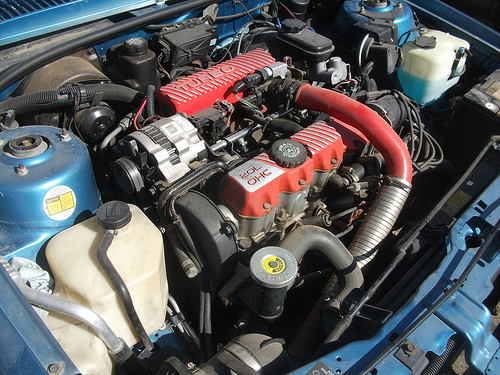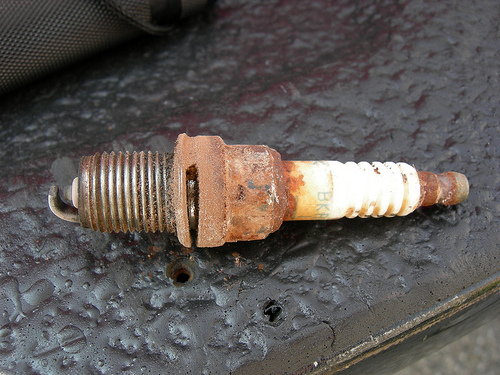DIY car maintenance can save you money

Fuel prices are still incredibly ridiculous. Will they ever drop below $3 per gallon again? It doesn't seem that way. Since it's becoming more and more difficult to save money on fuel, it's worth investing the time to learn how to save on automotive expenses in other ways. An easy way to save is by learning to do some routine maintenance tasks yourself. Here are a few you should know how to do, and they're fairly easy to learn.

Photo courtesy Jesse Wagstaff via Flickr.
Change the oil and oil filter
Changing the oil regularly is one of the most important elements of a maintenance schedule. By learning to change the oil and filter, you can save about $15 or more over going to a mechanic for an oil change. To change the oil:
- Allow the engine to cool down a bit if you were just in your car. It should be warm, but not hot, when you get started.
- Make sure your car is parked in a level spot. If so, jack up the car. Put on a pair of rubber or latex gloves.
- Find the oil pan and remove the drain plug to drain the old oil. (If you have a newer car, your drain plug may be hidden by an undercover. If so, take off the undercover.) Oil should always be drained into a recycling container so you can recycle it at your local gas station or auto shop.
- Clean and replace the drain plug.
- Find your oil filter and use an oil filter wrench to remove it. This is a messy step, hence the gloves. Make sure the rubber O-ring comes off with the old filter.
- Lubricate the O-ring on the new filter with oil.
- Take off the gloves, get a good grip on the new oil filter and screw it on until the O-ring makes contact with the surface to seal.
- Turn the filter three-quarters of a turn or a full turn, if necessary, to tighten it. Do not over tighten the filter; this can strip it.
- Confirm that the drain plug has been replaced (it never hurts to double-check).
- Remove your oil cap and place a funnel inside. Now it's time to add the oil. You'll be adding a little less than the recommended amount because you need to check the oil levels when your car is off the jack. Replace the oil cap after you've added the oil.
- Start the engine, and let it run for 30 seconds. Turn the vehicle off; check underneath the car for leaks. If everything is satisfactory, close the hood.
- Lower the car off the jack. Once the car is level, check the oil level. It will be slightly low since you added less than the recommended amount. Add oil until it measures at the upper hole or mark on your oil stick.

Photo courtesy dave_7 via Flickr.
Change the air filter
Your vehicle's air filter helps clean the air that passes through the engine and into the vehicle. A clean filter helps your car operate better by trapping small debris like sand and dirt and can build up and degrade your car's performance. Changing the air filter only takes a few minutes. A new filter costs about $10, but the procedure can cost $18 to $25 if a mechanic does it for you. Here's how you can do it:
- Pop open the hood and locate the filter. It's usually in a black case with metal clips on either side. Before removing the old filter, look at how it's placed for reference.
- Remove the old filter and replace it with the new one.
- Close the case and secure it.

Photo courtesy David Hepworth via Flickr.
Change the spark plugs
Spark plugs are responsible for helping your engine ignite and burn fuel efficiently. Whey they wear out, that spark gets weaker and can result in poor gas mileage, less power and other performance issues. New spark plugs if you do it yourself will run about $15. If you have a mechanic do it, it will cost at least $50 (if they're easy to get to) or can cost up to several hundred dollars or more. Here's how you can do it yourself:
- Locate your spark plugs. If you're not sure where they are, follow the thick, rubbery wires or look for the ignition coils. The number of spark plugs varies by car; there's usually one for each cylinder.
- Remove the wires or coils to expose the spark plugs. Alternately, you can do these one at a time so you don't get the wires mixed up.
- Remove the spark plugs. You'll need a ratchet with a spark plug socket (and possibly an extension) to do this.
- Install the new plugs. Tighten them by hand and finish with a wrench.
- Reattach the wires or coils to the plugs.
- Start the vehicle to ensure the engine is running smoothly.
Do you do routine maintenance on your vehicle? How much money does it save you?
Cover photo courtesy France1978 via Flickr.
2 comments